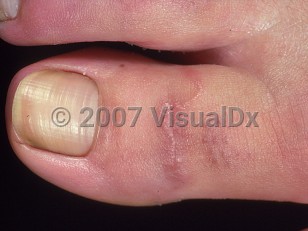Cutaneous larva migrans in Adult
Alerts and Notices
Important News & Links
Synopsis

Cutaneous larva migrans (also known as creeping eruption, creeping verminous dermatitis, sandworm eruption, plumber's itch, and duck hunter's itch) is a parasitic infestation of the epidermis. It is caused by larvae of hookworms that infect domestic dogs and cats or humans (Ancylostoma braziliense, Ancylostoma caninum, Uncinaria stenocephala, and Bunostomum phlebotomum). It is usually acquired by walking barefoot on soil or sand contaminated with dog or cat feces containing the larvae. After contact with the skin, larvae penetrate the epidermis and undergo a prolonged migration through the epidermis in a serpiginous, or "snake-like," fashion.
Clinically, there may be one or more intensely pruritic serpiginous tracts localized primarily to the ankles and feet; however, other areas of the body that have contacted infected soil may be involved. Itching begins within hours to days of exposure. Larval migration begins approximately 4 days after entry and progresses at a rate of around 1 or 2 cm a day. The tracts are often edematous, erythematous, and may have associated vesicles and bullae. Most patients present with more than one tract. Since the human is a "dead-end" host, the larva typically spontaneously resolve, although lesions may persist for up to a month.
The disease is most commonly found in warm climates, with high incidence observed in the southeastern United States, Central and South America, Africa, and the Caribbean.
Although very rare, larvae can migrate beyond the skin, causing systemic disease characterized by pulmonary infiltrates and peripheral eosinophilia, termed Loeffler syndrome.
Related topic: (Human) Hookworm infection
Clinically, there may be one or more intensely pruritic serpiginous tracts localized primarily to the ankles and feet; however, other areas of the body that have contacted infected soil may be involved. Itching begins within hours to days of exposure. Larval migration begins approximately 4 days after entry and progresses at a rate of around 1 or 2 cm a day. The tracts are often edematous, erythematous, and may have associated vesicles and bullae. Most patients present with more than one tract. Since the human is a "dead-end" host, the larva typically spontaneously resolve, although lesions may persist for up to a month.
The disease is most commonly found in warm climates, with high incidence observed in the southeastern United States, Central and South America, Africa, and the Caribbean.
Although very rare, larvae can migrate beyond the skin, causing systemic disease characterized by pulmonary infiltrates and peripheral eosinophilia, termed Loeffler syndrome.
Related topic: (Human) Hookworm infection
Codes
ICD10CM:
B76.9 – Hookworm disease, unspecified
SNOMEDCT:
19362000 – Cutaneous larva migrans
240854000 – Ancylostomal cutaneous larva migrans
B76.9 – Hookworm disease, unspecified
SNOMEDCT:
19362000 – Cutaneous larva migrans
240854000 – Ancylostomal cutaneous larva migrans
Look For
Subscription Required
Diagnostic Pearls
Subscription Required
Differential Diagnosis & Pitfalls

To perform a comparison, select diagnoses from the classic differential
Subscription Required
Best Tests
Subscription Required
Management Pearls
Subscription Required
Therapy
Subscription Required
References
Subscription Required
Last Reviewed:09/19/2018
Last Updated:09/19/2018
Last Updated:09/19/2018

